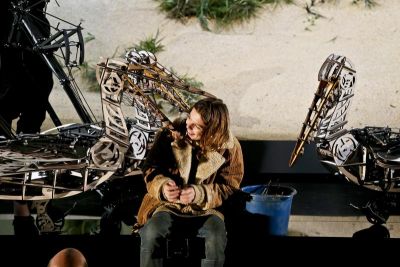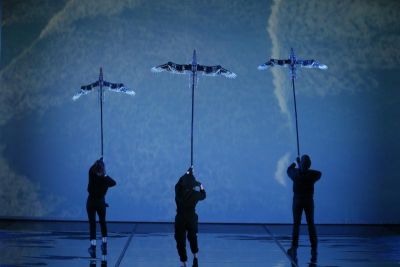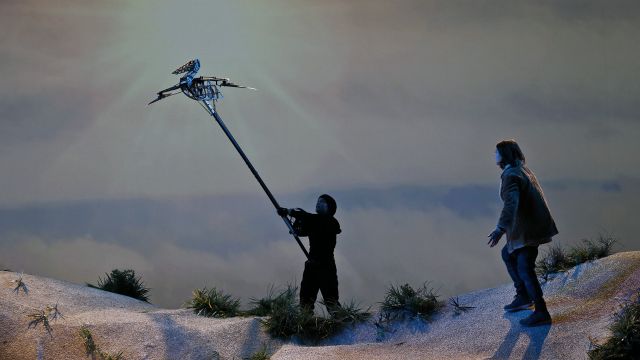Storm Boy
It began as a much-loved novel in 1964; then it was a much-loved movie in 1976; then Tom Holloway adapted the novel in 2013; then another not-so-loved try-hard movie in 2019; and now this MTC production of Mr Holloway’s text, directed by Sam Strong. You might ask, ‘Why?’, but adaptations and revivals are the go at present, the original story is ‘timeless’ and still timely, and Mr Strong hopes that this production will bring children to the theatre. I think he’s right: it will.
Hideaway Tom (here John Batchelor), bereft after the death of his wife and daughter, has retreated to the remote, deserted Coorong on the South Australian coast with his young son (Conor Lowe), who gets the sobriquet ‘Storm Boy’ from Fingerbone Bill (Tony Briggs) an indigenous man, also an isolate in this lonely place. The boy and Fingerbone bond over the care and rearing of pelican chicks orphaned by a storm.
 Dead Puppets Society’s stylised puppets represent the pelicans, of which ‘Mr Perceval’ is the other character in the story. David Morton designed the puppets and is also – necessarily – associate director. No attempt is made beyond black clothing to hide the puppeteers (highly skilled Ellen Bailey, Emily Burton and Drew Wilson) who also provide the birds’ cries. After a scene or so, you accept the convention: you forget the puppeteers and their constructions become real birds that are endearing, mischievous, funny and moving as they waddle about on the ground and soar and wheel through the sky.
Dead Puppets Society’s stylised puppets represent the pelicans, of which ‘Mr Perceval’ is the other character in the story. David Morton designed the puppets and is also – necessarily – associate director. No attempt is made beyond black clothing to hide the puppeteers (highly skilled Ellen Bailey, Emily Burton and Drew Wilson) who also provide the birds’ cries. After a scene or so, you accept the convention: you forget the puppeteers and their constructions become real birds that are endearing, mischievous, funny and moving as they waddle about on the ground and soar and wheel through the sky.
But reducing this big sky, isolated coast story to stage proportions presents the problem of the epic scope and scale of the Coorong where the story takes place and where, as director Sam Strong puts it, ‘you can feel genuinely alone, and be genuinely dwarfed by nature’. (There is, however and unfortunately, no scene here in which any character appears to feel genuinely alone or dwarfed by nature.) A huge amount of ingenuity, imagination and resources have gone to solving (over-solving?) the location problem.
 Justin Harrison has filmed kinetic images that are projected on a huge cyclorama: storm clouds, more clouds scudding across a vast sky, lines of breaking waves, and beautiful aerial images from high above of sea meeting land. Anna Cordingley’s detailed set provides Hideaway’s hut, sandhills dotted with heather and grasses, the glassy wet sand of the seashore, a tinnie on still water and on more water further out to sea.
Justin Harrison has filmed kinetic images that are projected on a huge cyclorama: storm clouds, more clouds scudding across a vast sky, lines of breaking waves, and beautiful aerial images from high above of sea meeting land. Anna Cordingley’s detailed set provides Hideaway’s hut, sandhills dotted with heather and grasses, the glassy wet sand of the seashore, a tinnie on still water and on more water further out to sea.
The production works hard and in the main successfully to be somewhere between theatrical and cinematic, but it is all so well done that it becomes almost a distraction through the many scene changes (another attempt at cinematic). But the sense of the locations’ reality is aided by Matt Scott’s lighting – another triumph: dawn, dusk, bright sunlight, gathering storm, shimmering water – and Darrin Verhagen’s sound design of sea and wind and howling thunderous storms. His terrific opening soundscape of a huge storm – which we hear in blackout – is powerful and frightening – and places us there in the Coorong.
 It is, of course, unfair to separate out all those elements from what we see on stage. It’s all of a piece, it’s a whole – and yet while so much is wonderful, the text itself is, I must say, not. The actors seem to be flattened out by the flatness and obviousness of their dialogue. Young Conor Lowe does his best, but all he has to say and do is rather predictable – as if too naturalistic. The humour is deliberately lame with the result that it’s no more than lame. It’s painful to see Tony Briggs’ energy and exuberance constrained and he and John Batchelor are saddled with clunky dialogue and sententious ‘author’s message’ speeches. It’s revealing, I think, that the audience decided the show was over – and began applauding – when the curtain came down for a final scene change. But, no: there was one more wrap-up scene to go – a scene that is necessary but not.
It is, of course, unfair to separate out all those elements from what we see on stage. It’s all of a piece, it’s a whole – and yet while so much is wonderful, the text itself is, I must say, not. The actors seem to be flattened out by the flatness and obviousness of their dialogue. Young Conor Lowe does his best, but all he has to say and do is rather predictable – as if too naturalistic. The humour is deliberately lame with the result that it’s no more than lame. It’s painful to see Tony Briggs’ energy and exuberance constrained and he and John Batchelor are saddled with clunky dialogue and sententious ‘author’s message’ speeches. It’s revealing, I think, that the audience decided the show was over – and began applauding – when the curtain came down for a final scene change. But, no: there was one more wrap-up scene to go – a scene that is necessary but not.
But perhaps none of this matters. The design elements are so awesomely convincing and the puppets so beguiling that the audience is swept up - in this particular iteration – in what seems a rather thin and obvious story. The many children – and many adults - in the audience on opening night were clearly entranced by the pelicans especially (so much credit to Mr Morton and the puppeteers) and I hope it’s not a spoiler to say that by the end there were tears as well as laughter.
Michael Brindley
Photographer: Jeff Busby
Subscribe to our E-Newsletter, buy our latest print edition or find a Performing Arts book at Book Nook.

